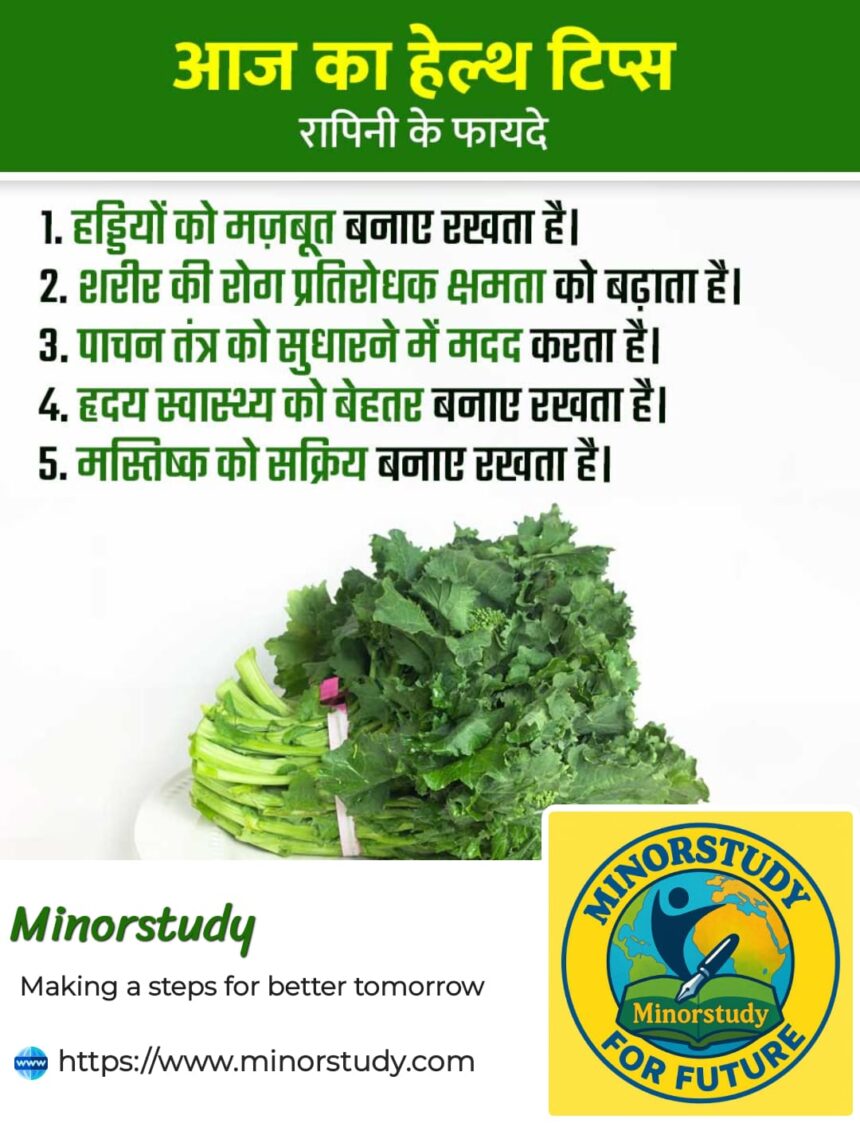5 Amazing Benefits of Rapini That Can Supercharge Your Health – A Powerful Green You Shouldn’t Ignore 💪🌱
In today’s world of fast food and processed meals, we often overlook traditional, nutrient-packed greens that our ancestors thrived on. One such underrated yet incredibly powerful green vegetable is Rapini — also known as Broccoli Rabe.
- 🥦 What is Rapini?
- ⏳ Historical and Cultural Timeline of Rapini
- 🌿 Nutritional Profile (Per 100g of Cooked Rapini)
- 💚 5 Amazing Benefits of Rapini – A Powerhouse for Your Body
- 1. 🦴 Keeps Bones Strong
- 2. 🛡️ Increases Immunity
- 3. 🌱 Improves Digestive Health
- 4. ❤️ Maintains Heart Health
- 5. 🧠 Keeps the Brain Active
- 🌍 Why Is Rapini Important in Modern Life?
- 🙏 Wishing and Observing the Power of Nature
- 🧠 Frequently Asked Questions (FAQs)
- Q1. Is Rapini the same as Broccoli?
- Q2. Is Rapini safe for children?
- Q3. How should Rapini be cooked?
- Q4. Can Rapini be eaten raw?
- Q5. How often should I eat it?
- 🎯 Key Takeaways & Important Points
- 🌱 Significance in Society and Wellness
- 🙌 Daily Life Impact
- 📘 Conclusion: Embrace the Power of Rapini Today
Packed with a unique blend of vitamins, minerals, and phytochemicals, Rapini is a superfood for your bones, brain, heart, and immune system.
In this detailed, human-centric guide, you’ll learn everything about Rapini — its origin, nutritional value, timeline in culinary culture, health benefits, FAQs, and impact on daily life, written in a human-friendly tone for better understanding and practical use.
🥦 What is Rapini?
Rapini, also known as Broccoli Rabe, is a leafy green vegetable with small buds that resemble broccoli but do not form a head. It has a slightly bitter and earthy flavor, making it a favorite in Mediterranean cuisine, especially Italian and Portuguese dishes.
Scientific Name: Brassica rapa (subspecies ruvo)
Family: Brassicaceae (same family as cabbage, kale, mustard greens)
Origin: Mediterranean region, particularly Italy
Indian Name: Sometimes referred to as Saag or Mustard greens substitute in hilly regions
⏳ Historical and Cultural Timeline of Rapini
| Period | Development |
|---|---|
| Ancient Rome | Cultivated for medicinal and digestive purposes |
| Middle Ages | Became a staple in Mediterranean monasteries |
| 17th–18th Century | Spread to other parts of Europe |
| Early 1900s | Immigrants brought Rapini to North America |
| Modern Times | Gaining popularity as a superfood in wellness communities |
🌿 Nutritional Profile (Per 100g of Cooked Rapini)
| Nutrient | Value |
|---|---|
| Calories | 22 kcal |
| Fiber | 3.5g |
| Vitamin K | 224% of RDA |
| Vitamin A | 87% of RDA |
| Vitamin C | 55% of RDA |
| Calcium | 10% of RDA |
| Folate | 16% of RDA |
| Iron | 6% of RDA |
💚 5 Amazing Benefits of Rapini – A Powerhouse for Your Body
1. 🦴 Keeps Bones Strong
Rapini is rich in calcium, vitamin K, and magnesium, which are essential for bone density and preventing osteoporosis.
Tip: Add lightly steamed rapini to your soup or dal for a calcium boost.
2. 🛡️ Increases Immunity
Packed with Vitamin C, A, and folate, rapini strengthens the immune system, helping your body fight infections naturally.
Tip: Use in warm broths during flu season for a natural immune boost.
3. 🌱 Improves Digestive Health
Thanks to its fiber-rich content, rapini aids in digestion, prevents constipation, and supports gut-friendly bacteria.
Tip: Pair it with curd or fermented foods for maximum probiotic synergy.
4. ❤️ Maintains Heart Health
The antioxidants, potassium, and fiber in rapini help reduce bad cholesterol, control blood pressure, and protect heart tissues.
Tip: Stir-fry with olive oil and garlic – heart-healthy and delicious!
5. 🧠 Keeps the Brain Active
Rapini contains folate, iron, and antioxidants that promote cognitive clarity, memory retention, and reduce inflammation in the brain.
Tip: Combine with walnuts or almonds for a complete brain-boosting salad.
🌍 Why Is Rapini Important in Modern Life?
In a world filled with junk, rapini is a reminder that natural, earthy vegetables still hold immense value. Here’s why you should embrace this powerful green:
✅ Affordable and easy to cook
✅ Sustainable farming crop
✅ Perfect for vegetarian and vegan diets
✅ Helps combat lifestyle diseases like diabetes, hypertension, and obesity
✅ Safe for all age groups, including children and elders
🙏 Wishing and Observing the Power of Nature
Let us celebrate this humble yet potent vegetable by reintroducing traditional greens into our lives. Next time you’re buying spinach or mustard greens, try adding rapini to your plate.
🌿 “On this day, let’s honour the gifts of nature like Rapini – small in size, mighty in strength.”
🧠 Frequently Asked Questions (FAQs)
Q1. Is Rapini the same as Broccoli?
No. Though they look similar, rapini and broccoli are different species. Rapini is leafier and more bitter.
Q2. Is Rapini safe for children?
Yes, when cooked properly, rapini is safe and nutritious for kids — great for bone and brain development.
Q3. How should Rapini be cooked?
Light sauté with garlic and oil
Steamed with lemon and herbs
Added to soups, pasta, or Indian curries
Q4. Can Rapini be eaten raw?
It’s better cooked or blanched to reduce bitterness and enhance nutrient absorption.
Q5. How often should I eat it?
2–3 servings per week is ideal for noticeable health benefits.
🎯 Key Takeaways & Important Points
Rapini is a nutrient powerhouse, especially for bones, brain, and immunity.
It has a rich historical legacy in global culinary traditions.
Helps in preventing chronic diseases naturally.
Must be properly cooked to reduce bitterness and unlock nutrients.
Suitable for every age group and dietary preference.
🌱 Significance in Society and Wellness
In modern India and across the globe, the rise in lifestyle diseases, nutrient deficiencies, and gut issues calls for a return to traditional greens like Rapini. It promotes:
✅ Sustainable agriculture
✅ Affordable nutrition for all
✅ Encourages home cooking and mindful eating
✅ Supports Ayurvedic and holistic healing systems
🙌 Daily Life Impact
Adding Rapini to your meals can result in:
Better digestion
Increased mental clarity
Stronger immunity
Stable blood sugar and cholesterol
A happier gut and sharper brain
📘 Conclusion: Embrace the Power of Rapini Today
Rapini might not have the hype of kale or the mass appeal of spinach, but it packs a silent punch of wellness. As you walk the journey of better health and holistic living, let Rapini be your green companion.
🌿 “Let food be thy medicine and medicine be thy food.” – Hippocrates
Incorporate rapini into your weekly menu and experience the magic of mindful eating.








